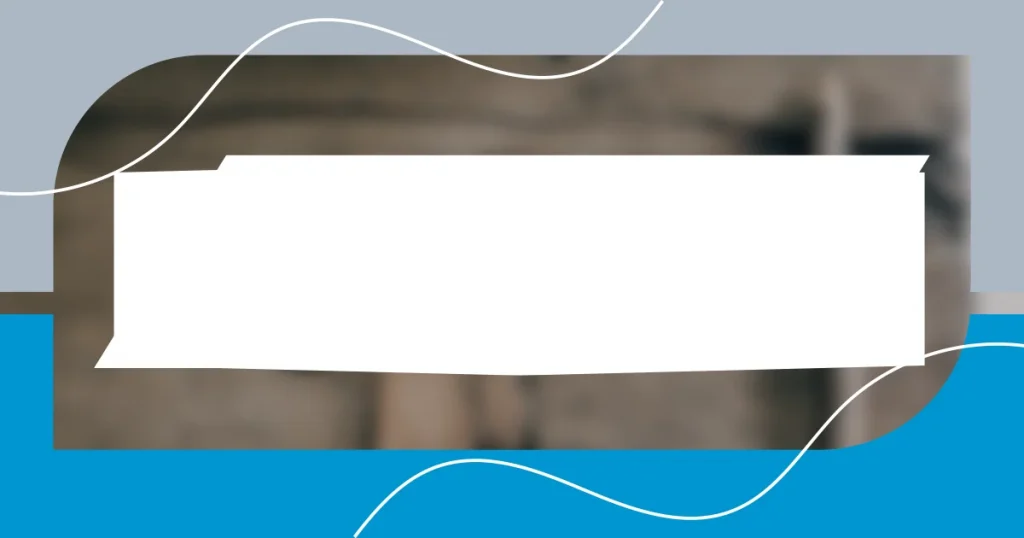Key takeaways:
- Understanding the types of sealants (oil-based, water-based, lacquer, polyurethane) and their applications is crucial for achieving desired finishes and durability.
- Proper wood preparation (cleaning, sanding, dust removal, ensuring dryness) significantly impacts the sealing process and final results.
- Regular maintenance, including reapplying sealant and protecting surfaces from environmental factors, is essential for the longevity and appearance of sealed wood.

Understanding wood sealing basics
When I first started sealing wood, I was surprised by how much it could transform the appearance of a piece. The right sealant not only enhances the grain but also protects it from moisture and wear, making it crucial for longevity. Have you ever considered how a simple finish can bring out the hidden beauty in a project?
Understanding wood sealing basics means knowing the different types of sealants available. For instance, I’ve often faced the dilemma between oil-based and water-based options. Each has its own set of properties and drying times. Personally, I’ve found that while oil-based sealants provide a rich finish, they can be much slower to clean up.
I remember the first time I applied a sealant that was too thick, thinking it would help protect my wood better. It ended up looking lumpy and uneven, which was a frustrating lesson. Have you encountered something similar? It’s essential to find the right balance in application for a smooth finish.

Choosing the right sealant
Choosing the right sealant can feel daunting at first, but it doesn’t have to be. I remember when I was faced with a big project, and I spent hours researching different types of sealants. The difference between a polyurethane sealant and a lacquer could make or break my project. I learned that polyurethane is incredibly durable, making it perfect for high-traffic areas, while lacquer dries quickly and is great for achieving a high-gloss finish. What has your experience taught you about different sealants?
Another critical factor in choosing a sealant is the specific application method. I recall a time when I used a brush to apply a sealant, thinking it would give me precision, but I quickly realized that spray application could save time and reduce streaking. It’s fascinating how the right method can lead to a finished product that not only looks professional but also stands the test of time. Have you ever experimented with different application techniques?
Here’s a handy comparison table to help you make a decision:
| Sealant Type | Best For |
|---|---|
| Oil-based | Durability and rich finishes |
| Water-based | Quick drying and easy cleanup |
| Lacquer | Fast application and high gloss |
| Polyurethane | Heavy use areas |

Preparing wood for sealing
Preparing wood for sealing is a fundamental step that can make a world of difference in your project’s outcome. I remember a time when I rushed through this phase, thinking it was just about applying the sealant. But I learned the hard way that proper preparation is key. The surface needs to be clean, smooth, and dry to ensure that the sealant adheres properly and provides the desired protection and aesthetic.
Here are essential steps for preparing wood before sealing:
- Clean the surface: Remove dust, dirt, and grease with a mild detergent or denatured alcohol.
- Sanding: Use sandpaper or a sanding block to smooth out rough spots. I often start with a coarser grit and finish with a fine one to prepare the surface well.
- Remove dust: After sanding, wipe the wood down with a tack cloth or a damp rag. I find this step crucial; it’s amazing how much dust can affect the final finish.
- Drying: Ensure the wood is thoroughly dry before applying any sealant. I’ve occasionally skipped this step and regretted it when the finish bubbled up later on.
- Test for compatibility: If you’re unsure, a small test area can tell you how the wood reacts with the sealant, sparing you potential headaches later.
Taking the time to properly prepare the wood will ensure a smoother and more successful sealing process. I’ve noticed that it not only impacts the finish but also how the wood stands up to wear over time.

Techniques for applying sealants
Applying sealants effectively can significantly enhance your woodworking projects, and I’ve discovered a few techniques that really make a difference. When working on a recent project, I opted for a foam roller instead of a brush, and the results were remarkable. The roller helped me achieve an even coat and avoid the pesky brush marks that often show up. Have you ever been frustrated by imperfections in your finish? Using the right tool can change everything.
Another approach I’ve found effective is layering the sealant. Instead of slapping on one thick coat, I apply multiple thin layers, allowing each one to dry thoroughly before the next. This not only improves durability but also gives the wood a deeper, richer finish. I remember being hesitant at first, thinking it would be more time-consuming. However, I was pleasantly surprised by how much stronger and aesthetically pleasing the final product turned out. How do you feel about investing a bit more time for a better end result?
Lastly, don’t underestimate the power of environmental conditions when sealing wood. I once miscalculated the humidity levels on a warm summer day, and it affected the drying time significantly. If the air is too humid, the sealant may not dry properly, leading to a tacky mess. I’ve since learned to check the weather and choose my sealing days wisely. What’s your go-to strategy for ensuring the best conditions during your projects?

Maintaining sealed wood surfaces
To keep sealed wood surfaces looking their best, regular maintenance is crucial. I’ve often been caught off guard by how quickly dust and grime can accumulate, especially in high-traffic areas. Simple solutions, like damp cloths and gentle cleaners, can do wonders in restoring that fresh, polished look without compromising the seal.
I learned the importance of reapplying sealant when I found a lovely wood table showing signs of wear. It was disheartening to see the finish dulled and chipped after just a few months. Now, I make it a point to inspect sealed surfaces every six months and apply a fresh coat beneath areas that need it most. Have you had a similar experience where a little touch-up made a significant difference?
Finally, protecting sealed wood from harsh elements is essential. I vividly remember a project where I failed to provide appropriate shielding from sunlight and water. The UV rays wreaked havoc on the color, and moisture led to bubbling. Since then, I’ve prioritized using protective covers when my pieces are outdoors, making a world of difference in longevity. Have you thought about how environmental factors play a role in maintaining your sealed finishes? The right precautions can extend the life of your wood, saving you time and effort in the long run.

Troubleshooting common sealing issues
When sealing wood, issues like bubbling or streaking can really dampen your enthusiasm. I remember one time, I was almost finished sealing a beautiful cedar bench when I noticed bubbles forming after the first coat. It was incredibly frustrating! After some quick research, I discovered that applying the sealant too thickly can trap air. I learned to focus on applying thinner coats and ensuring I worked in a well-ventilated space. Have you encountered bubbling before, and how did it affect your project?
Another common issue is improper adhesion, which can leave you feeling defeated. I once had a beautiful piece of pine that I prepared meticulously, but after sealing, I noticed parts of the finish peeling away. It turns out, I hadn’t adequately cleaned the surface before application, which is crucial. A good clean-up removes dust and oils that can prevent the sealant from bonding properly. It’s a small step that makes a significant impact. Have you ever overlooked surface prep and faced the consequences?
Lastly, if you’ve noticed discoloration after sealing, that can be disheartening, too. I remember sealing a mahogany table and, to my horror, it turned a lighter shade than expected. This happened because I didn’t test the sealant on a scrap piece first. Always do a test run! It’s a simple yet effective way to avoid surprises. Have you taken the time to test your products before diving in on larger pieces? It can save you time and heartache in the end.














